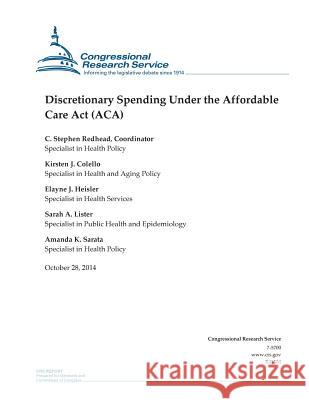Discretionary Spending Under the Affordable Care Act (ACA) » książka
Discretionary Spending Under the Affordable Care Act (ACA)
ISBN-13: 9781503089839 / Angielski / Miękka / 2014 / 52 str.
Discretionary Spending Under the Affordable Care Act (ACA)
ISBN-13: 9781503089839 / Angielski / Miękka / 2014 / 52 str.
(netto: 76,04 VAT: 5%)
Najniższa cena z 30 dni: 79,84
ok. 16-18 dni roboczych
Bez gwarancji dostawy przed świętami
Darmowa dostawa!
The Patient Protection and Affordable Care Act (Affordable Care Act, or ACA) reauthorized funding for numerous existing discretionary grant programs administered by the Department of Health and Human Services (HHS). The ACA also created many new discretionary grant programs and provided for each an authorization of appropriations. Generally, the law authorized (or reauthorized) appropriations through FY2014 or FY2015. This report summarizes all the discretionary spending provisions in the ACA. A companion product, CRS Report R41301, Appropriations and Fund Transfers in the Affordable Care Act (ACA), summarizes all the mandatory appropriations in the law. Among the provisions that are intended to strengthen the nation's health care safety net and improve access to care, the ACA permanently reauthorized the federal health centers program and the National Health Service Corps (NHSC). The NHSC provides scholarships and student loan repayments to individuals who agree to a period of service as a primary care provider in a federally designated Health Professional Shortage Area. In addition, the ACA addressed concerns about the current size, specialty mix, and geographic distribution of the health care workforce. It reauthorized and expanded existing health workforce education and training programs under Titles VII and VIII of the Public Health Service Act (PHSA). Title VII supports the education and training of physicians, dentists, physician assistants, and public health workers through grants, scholarships, and loan repayment. The ACA created several new programs to increase training experiences in primary care, in rural areas, and in community-based settings, and provided training opportunities to increase the supply of pediatric subspecialists and geriatricians. It also expanded the nursing workforce development programs authorized under PHSA Title VIII. As part of a comprehensive framework for federal community-based public health activities, including a national strategy and a national education and outreach campaign, the ACA authorized several new grant programs with a focus on preventable or modifiable risk factors for disease (e.g., sedentary lifestyle, tobacco use). The new law also leveraged a number of mechanisms to improve health care quality, including new requirements for quality measure development, collection, analysis, and public reporting; programs to develop and disseminate innovative strategies for improving the quality of health care delivery; and support for care coordination programs such as medical homes and the co-location of primary health care and mental health services. Additionally, the ACA authorized funding for programs to prevent elder abuse, neglect, and exploitation; grants to expand trauma care services and improve regional coordination of emergency services; and demonstration projects to implement alternatives to current tort litigation for resolving medical malpractice claims, among other provisions. The Congressional Budget Office estimated that the ACA's discretionary spending provisions, if fully funded by appropriations acts, would result in appropriations of approximately $100 billion over the 10-year period FY2012-FY2021. Much of that funding would be for discretionary programs that existed prior to, and whose funding was reauthorized by, the ACA. While most of those existing discretionary programs continue to receive an annual discretionary appropriation, albeit at levels below the amounts authorized by the law, few of the new grant programs authorized under the ACA have received any discretionary funding. However, several of the new programs have received mandatory funds from the ACA. This report is periodically revised and updated to reflect important legislative and other developments.
Zawartość książki może nie spełniać oczekiwań – reklamacje nie obejmują treści, która mogła nie być redakcyjnie ani merytorycznie opracowana.











